This recipe for Uppu seedai from store bought flour is quite simple, if one follows the instructions meticulously. This is the first Krishna Jayanthi that I am spending with my daughter, son in law and granddaughter whom I am visiting in the USA. I am not good at making sweets, let me confess. Perhaps because I haven't tried them out much. However the success story of the Uppu Seedai for Gokulashtami has now made me venture out to try sweets and savouries for festivals.
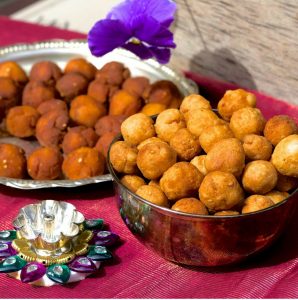
In India, it is easy to get well made delicious sweets and savouries from the mithai shops or from stores like Shri Krishna Sweets or The Grand Sweets or from online stores. Anyway my mother had been sending me the sweets for this festival for may years, so there was no incentive to try making a reputedly difficult item.
My daughter Lakshmi has been painstakingly making all the appropriate sweets for each festival ever since she came here, but this time I wanted to be the one to make the uppu seedai and vella seedai, the traditional Tamilian Gokulashtami naivedyam delicacies.
When I started checking out recipes, I found that almost all of them required the rice (and urad dhal) to be soaked and then ground/powdered into flour, which I didn't want to do as I didn't think the food processor would give me the consistency of flour required and it would anyway have taken up more time than I could afford today. I took Lakshmi's advice and made the uppu seedai from store bought flour, both for the rice flour and urad flour.
I am glad to say that both the vella seedai and the uppu seedai from store bought flour have turned out really well! I am feeling very proud of myself, especially because though I referred a number of recipes starting with the one in the Samaythipar or Cook and See book as well as some popular blogs which I rely on, I finally set them all aside and planned ingredients in proportions that seemed workable. And of course, I used ready made packaged flour rather than home made.
Here is the link to my recipe for Vella Seedai, also with store bought flour.
One reason many of us (including me) are hesitant to try making uppu seedai is because of their unsavoury reputation of bursting when the dough balls are put into the hot oil. In this recipe I will tell you the steps I took to prevent them from bursting like little dough explosives!
Tips to keep Uppu Seedai from bursting while being fried:
- You have the advantage when you make uppu seedai from store bought flour, as the flour is usually finely powdered. The flour should be really fine. Coarse flour can cause the uppu seedai to burst.
- The ingredients need to be smoothly mixed into the dough and once this is done (with no dry flour showing through) stop mixing or moulding it.
- Once the dough has been mixed into a soft pliable lump, let it sit for 10 -15 minutes on a kitchen towel/ kitchen tissue to dry. Wet dough is more likely to explode during frying, than dry dough.
- When making dough balls, don't make them smooth or spend too much time rolling them. Just pat them between the palms of your hands into rough little balls. They do not have to be perfectly round. In fact, the seedai is likely to explode when it doesn't find cracks for the hot air to escape during frying.
- Roast the coconut before adding to the dough, to reduce moisture content.
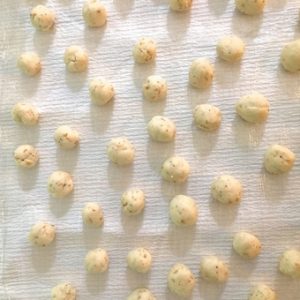
Other kitchen hints to make uppu cheedai or uppu seedai from store bought flour:
- Dry roast the flours before using (i.e. roast in a pan without oil) without letting the flour brown or darken.
- Use only as much water as is needed for a pliable dough that is not sticky, from which you can easily roll the dough balls.
- Mix the sesame seeds nicely into the dough, otherwise they will separate from the dough and float into the oil while frying.
- When adding salt to the dough, add less than the volume in the recipe, then taste and add more if required. I found 1 teaspoon perfect for the volume of flour, but this would depend on the brand of salt that you are using. I did face a problem as I do not taste the ingredients or the final product when making anything for naivedyam, till it is offered to the Gods during pooja. Next year I won't have to worry as I now know exactly how much salt is required!
- Soak the asafoetida in water as in the instructions below, so that it spreads uniformly in the dough.
- Keep in mind that the uppu seedai may still explode, inspire of all the precautions, so keep a safe distance from the stove when frying the first batch. Keep the rest of the batter covered and don't allow any moisture to ingress, such as by putting wet hands or a wet ladle into the dough.
If you liked this recipe, you may also like:
Vella Seedai for Gokulashtami
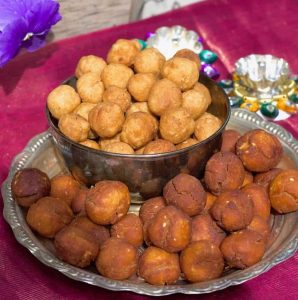
Kesar Badam Halva - Dessert of Almonds, Milk and Saffron
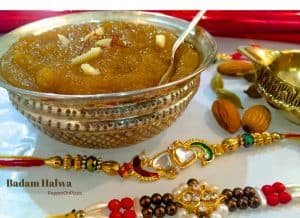
Vanilla Apricot Black Rice Kheer
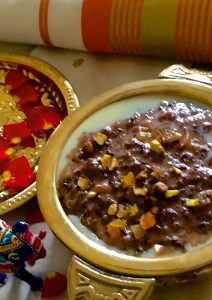
Puliyodharai- Tamarind rice from Pulikachal
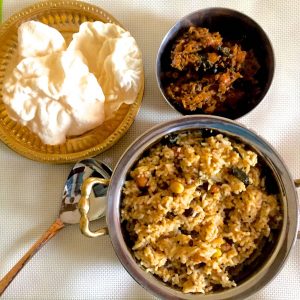
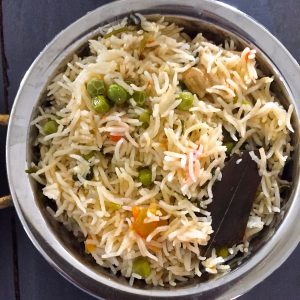
"Recipe"
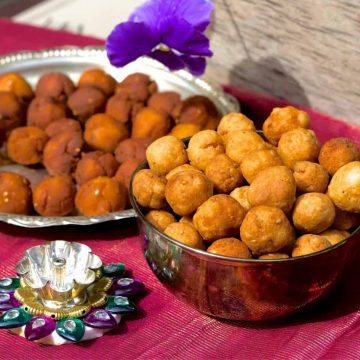
Easy Uppu Seedai From Store Bought Flour
Ingredients
- 1.5 cups rice flour flour should be fine and not coarse
- 2 tablespoons black gram/ urad dhal flour ulutham mavu
- 2 teaspoons white Sesame seeds white ellu / white til seeds
- ½ teaspoon pepper cumin powder finely powdered milagu jeera
- 1 teaspoon table salt or to taste
- ¼ teaspoon asafoetida hing powder peringayam powder
- 2 teaspoons roasted grated coconut or very thin small pieces
- 3 tablespoons unsalted butter or to taste
- 1 cup water as much required for a soft dough that is not sticky or wet
- 2 cups oil or as much required for deep frying the dough
Instructions
To prepare the Dough for Uppu Seedai
- 1. Sieve and Roast the flours separately in a hot pan on low heat, stirring frequently, for about 2 minutes. The flour should not brown or catch at the bottom of the pan. 2. Soak the asafoetida (hing) powder in a teaspoon full of water, stir to dissolve it as much as possible. Set aside till required. 3. Melt the butter ( I microwaved it for 20 seconds till is just began to melt) 4. Roast the coconut in a dry pan for 2 minutes, without letting it brown.
- In a large bowl, add together the dry ingredients, i.e. the rice flour, urad dhal flour, sesame seeds, pepper cumin powder, roasted coconut pieces and salt (add a little salt, and after the dough is mixed, taste and add more if required). Mix the dry ingredients well together.
- Make a well in the centre of the flours, add the melted butter and asafoetida water, mix well. Add water gradually and mix the dough just until you get a soft, pliable dough that is not sticky or wet. Be cautious when adding water and add only as much as you need. Taste the dough for adequacy of salt. Shape the dough into a rough ball.
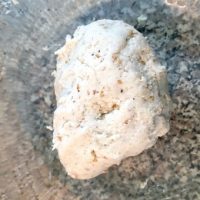
- Set the dough aside onto a clean dry kitchen towel or food grade tissue, and allow it to dry for about 15 minutes.
To make the Uppu Seedai
- After the dough has rested, shape it into small odd shaped balls. You must roughly pat the dough between the palms of your hands and not make them smooth or perfectly round or mould them for too long.
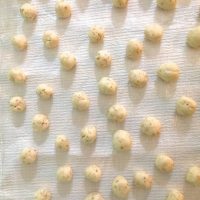
- Heat oil in a pan. My daughter gave me a small sauce pan so I could fill it to half its height in oil, which gave enough depth for the seedai to fry in a small quantity of oil. rather than a kadai full of oil.
- Once the oil is really hot, reduce the flame to low. To test whether the oil is hot enough, add a very small bit of dough to the oil, and if the dough rises immediately and bubbles start forming around it, the oil is hot.
- Add some of the dough balls. Do not crowd the pan as the dough should have space to fry. The oil will tend to splash when you add the dough even gently, so keep away and use a ladle as I did, to add the dough balls to the oil.
- If the seedai is going to burst, you will know soon enough. If it stays stable for 3 minutes, you know its going to be fine! If it does burst, add a very little dry roasted rice flour to the dough to reduce the moisture. It may help. And keep a distance from the pan when the seedai is frying, to be safe.
- After 4 minutes, gently turn the seedai in the oil with a slotted ladle, so that it cooks uniformly. The colour will begin to darken. When it reaches a golden shade and then begins to brown (for me it took about 6 minutes on low flame) remove the seedai after draining the oil and remove to a dry colander or to a kitchen towel to drain. Add the next batch, which will normally get done faster as the oil would have reached the right temperature.
- Transfer all the seedai to a dry container (avoid plastic) and cover with a closely fitting lid only after it has cooled and reached room temperature.


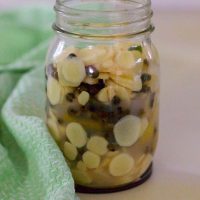
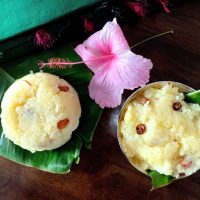
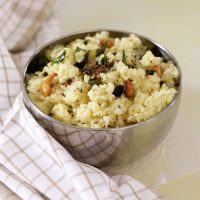
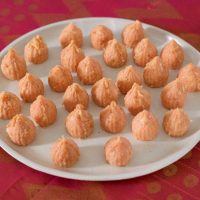
Swati says
I am not very familiar with seedai sounds interesting recipe.. looks delicious and perfect for the festive season.. I think the key to make a perfect seedai is fine flour and the way it is kneaded.. will try this..
Sujata Shukla says
Thank you, Swati. It is a traditional sweet prepared for Shri Krishna Jayanthi by Tamilians and in other parts of South India. Yes, the flour is important as well as keeping the moisture level very low. And very little pressing and kneading to be done.